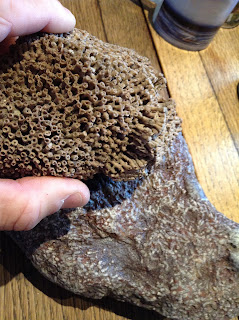The lovely mother of pearl details on this wardrobe produced interesting pastel colours which changed as I moved. The theory is called thin film interference. Basically, there is partial reflection of light from the top surface so some light is transmitted to hit the bottom surface. Again, some of the light is reflectd back up from the bottom surface and this will interfere with the reflected light from the top surface. Because they have gone different distances, their waves will be at different points in the cycle. If they line up so that peak meets peak, there is constructive interference are we see a colour. The colour will change with movement because a different angle will mean that the light has travelled a different distance through the mother of pearl and with each colour having a different wavelength, that change in distance will affect whether peak meets peak. What has been bothering me is that you don't see the true colours of the classic rainbow spectrum.
This article lists browns, golds, turquoises, teals, magentas. Some of those are secondary colours so more than one wavelength must be experiencing constructive interference. The article talks about bandwidth.





























